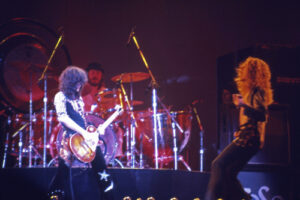
Photo: Masahiro Sumori, CC BY-SA 3.0 <http://creativecommons.org/licenses/by-sa/3.0/>, via Wikimedia Commons
Compiling a list of the top 10 Chuck Berry songs is challenging for several reasons. Many music fans and historians regard Chuck Berry as the man who invented rock and roll. While that claim isn’t entirely valid—rock and roll is an art form that evolved over a long period—there is no disputing that Chuck Berry’s single “Maybellene” was the song that introduced rock and roll to a mass audience and launched Berry’s career. From that point on, in 1955, Berry began releasing singles that would have a monumental impact on the music world. Chuck Berry and his band, including Johnnie Johnson on piano, Willie Dixon on bass (the legendary blues artist Willie Dixon), and Ebby Hardy on drums, helped shape the template for the rock and roll sound that would inspire generations to come.
This band played a significant role in Chuck Berry’s success. One cannot discount the contributions of Johnnie Johnson on piano or how Berry adapted Johnson’s piano riffs to the guitar. Additionally, Willie Dixon was one of history’s most influential blues artists. His songs have been recorded by countless rock legends, from Led Zeppelin to Jimi Hendrix and Stevie Ray Vaughan. Dixon’s bass lines in Berry’s songs provided a powerful groove that intensified the rock sound in a way that hadn’t been done before. Ultimately, Chuck Berry’s distinctive guitar playing, his vocals, his clever lyrics, and his infectious melodies turned the music industry on its head in the 1950s. Chuck Berry is, and will forever be, the Father of Rock and Roll.
# 10 – Rock And Roll Music – One Dozen Berrys
We open up our top 10 Chuck Berry songs list with Chuck Berry’s classic song “Rock and Roll Music.” How could we not start with this one? This is what it is all about. Chuck Berry wrote the song in 1957. It was released as a stand-alone single on Chess Records in 1957. “Rock and Roll Music” became Chuck Berry’s third top 10 hit on the Billboard Hot 100. His previous top 10 singles were “Maybelline,” in 1955, and “School Day,” in 1956. Besides hitting number 8 on the Billboard Hot 100, “Rock and Roll Music.” would chart even higher on the Billboard R&B charts, peaking up to number 2. The song was released on Chuck Berry’s second album, One Dozen Berrys, in 1958.
“Rock and Roll Music.” would become a hit in three straight decades, covering the 1950s, 1960s, and 1970s. The Beatle’s love affair with Chuck Berry’s music resulted in the group recording a version of the song in 1964. The song was released on their fourth UK Album entitled Beatles For Sale. The song hit number one in Australia, Norway and Sweden. The Beach Boys had a hit with the song in 1976. The band released it as the lead-off single from their 15 Big Ones album. The song hit number five on the Billboard Hot 100 in 1976 for The Beach Boys.
# 9 – Carol
Continuing with our Top 10 Chuck Berry Songs list we turn to his female titled rocker “Carol.” Opening up with those signature Chuck Berry guitar licks, the song Carol stands as one of Chuck Berry’s most famous songs. “Carol” was released in 1958. The song hit number 18 on Billboard’s Hot 100 and number 9 on the R&B charts. The track is built around Berry’s signature guitar riffs, which helped lay the groundwork for future rock music. It also features his distinctive blend of blues and early rock, with lyrics that tell the story of a young man’s determination to win over the heart of a girl named Carol.
In the song, Berry’s narrator tries to persuade Carol not to be swayed by another man. He tells her, “I’m gonna learn to dance if it takes me all night and day,” a line that captures both youthful optimism and romantic tenacity. The setting— a “swinging little joint” where everyone is “jumping and shouting”— brings the lively energy of a rock and roll dance hall to life, reflecting the excitement of the time.
The song’s rhythmic guitar riff is a central component of its appeal. It is a sound Berry popularized, one that would go on to influence countless rock musicians. “Carol” was famously covered by The Rolling Stones on their debut album in 1964, where they stayed true to the original while adding their own raw, bluesy flavor. The Stones also performed a live version on Get Yer Ya-Ya’s Out! in 1970, further cementing the song’s importance in rock history. The Beatles also performed the song in 1963 during a BBC session, and it has been interpreted by numerous other artists.
Berry’s lyrics in “Carol” encapsulate the urgency of young love and the determination to impress someone through the art of dance, a popular social theme at the time. The song’s success comes not only from its catchy guitar lines and danceable rhythm but also from its relatability— a young man trying to win over a girl and learn to dance to keep her interest. This theme of love and determination, combined with Berry’s innovative guitar work, keeps “Carol” as a timeless piece of rock history.
# 8 – School Days
If you have ever heard the term Hail! Hail! Rock and Roll and wonder where it originated, look no further. Chuck Berry’s classic single “School Days” contained the line that would be utilized as the title to the great Chuck Berry movie in 1987 entitled Hail! Hail! Rock and Roll. Chuck Berry’s “School Days” had so many great lines like “Drop the coin right into the slot. You’re gotta hear somethin’ that’s really hot.” or that great opening line, “Up in the mornin’ and out to school, The teacher is teachin’ the golden rule.” These were lyrics that became ingrained in rock and roll society. At times, Chuck Berry’s vocals and phrasings were just as impressive and addictive as his guitar licks. “School Days” is the perfect example of that skill set that Chuck Berry defined every time he took a step onto the concert stage.
# 7 – No Particular Place to Go
“No Particular Place to Go,” released in 1964, is one of Chuck Berry’s most iconic tracks. The song blends Berry’s signature rock and roll sound with witty storytelling, capturing the essence of youthful freedom. In it, Berry narrates a tale of a romantic car ride gone humorously wrong, as the couple finds themselves unable to unbuckle the seatbelt when the night takes a romantic turn. With its playful lyrics, catchy melody, and Berry’s driving guitar, the song embodies the carefree spirit of early rock and roll.
Recorded at Chess Studios in Chicago, the song was part of Berry’s comeback album St. Louis to Liverpool, released during a transitional time in his career. After serving time in prison, Berry returned to the music scene with new vigor, and “No Particular Place to Go” became one of his biggest hits from this era. It reached number 10 on the Billboard Hot 100 chart, showcasing Berry’s undiminished appeal to both longtime fans and a new generation of listeners.
Lyrically, the song cleverly mirrors one of Berry’s earlier hits, “School Days,” both employing the theme of driving, but while “School Days” is more focused on the liberating escape of the weekend, “No Particular Place to Go” zeroes in on a comedic frustration. Lines like “Riding along in my automobile / My baby beside me at the wheel” capture the simple joy of cruising, while the narrative twist with the seatbelt adds humor and charm. Berry’s ability to tell stories with relatable yet clever lyrics is one of the reasons his music has such enduring popularity.
# 6 – Promised Land
Even though Chuck Berry’s “Promised Land” opens with his signature guitar licks, the song quickly shifts into a more driven, narrative style. This represents a different side of Berry, heavily influenced by his time in prison, where he wrote the song. In simple terms, “Promised Land” is a masterpiece, offering a profound commentary on society. It’s a journey song, a statement of hope and promise.
The song reflects the classic American story, one that has been repeated throughout history—the road to happiness, wealth, and opportunity, often leading to California, which has long been hailed as a “Promised Land” for those seeking a better life. Whether it was the Gold Rush, the promise of land, or fame in the entertainment industry, California symbolized new beginnings for millions of people. For immigrants and people living outside of the U.S., the country itself was seen as the ultimate Promised Land, a place of potential prosperity and freedom. This idea resonates even today, despite the social and political challenges of recent years.
# 5 – Sweet Little Sixteen
“Sweet Little Sixteen” is one of Chuck Berry’s most iconic songs, written and recorded in December 1957 and released as a single in January 1958. The song quickly became a hit, reaching number two on the Billboard Hot 100 and topping the R&B Best Sellers chart. The track was part of Berry’s influential catalog that helped define the sound of rock and roll. The recording featured some of the era’s best musicians, including Lafayette Leake on piano, Willie Dixon on bass, and Fred Below on drums. Berry’s intricate guitar work and catchy melodies, combined with his ability to capture youthful energy in his lyrics, made “Sweet Little Sixteen” a cornerstone of rock music.
Lyrically, “Sweet Little Sixteen” tells the story of a young girl obsessed with rock and roll culture, dreaming of fame and adoration. She collects autographs, attends concerts, and has become a part of the fan craze. With references to different cities across the United States, including Boston, St. Louis, and New Orleans, the song emphasizes rock and roll’s nationwide influence and appeal. The line, “All the cats wanna dance with Sweet Little Sixteen,” captures the youthful excitement and energy that Berry so expertly conveyed in his songs.
The song’s success also led to an interesting turn of events when The Beach Boys borrowed its melody for their 1963 hit “Surfin’ U.S.A.” Berry’s publisher took legal action, resulting in Brian Wilson giving the songwriting credit to Chuck Berry. Additionally, The Beatles recorded “Sweet Little Sixteen” for a radio session in 1963, and John Lennon later covered the song on his 1975 Rock ‘n’ Roll album, solidifying the song’s legacy in the annals of rock history. Berry’s lyrics and music in “Sweet Little Sixteen” continue to resonate, reflecting the vibrant teenage culture of the 1950s and the evolution of rock and roll.
# 4 – You Never Can Tell
Chuck Berry’s “You Never Can Tell“ is one of those great underrated songs that flew under the radar for many years. That was until the brilliant director Quentin Tarantino utilized the song in his 1994 breakthrough film Pulp Fiction. “You Never Can Tell” was initially released thirty years earlier, in 1964. Written by Chuck Berry, the song was a top 20 hit on both the Billboard Hot 100 and R&B Charts. Interestingly, it peaked at number 14 on both charts in 1964.
https://www.youtube.com/watch?v=u9l0YBKcGnY
# 3 – Maybelline
These next three rock and roll Chuck Berry songs represent three of classic rock history’s most important and legendary songs. Up first is Chuck Berry’s debut single, “Maybelline.” This song is far more than just Chuck Berry’s debut single; it is rock and roll history’s debut hit single. Bill Haley had already been experimenting with a sound derived from jump blues early in the 195os. Many argue that the song “Rocket 88,” is the first real rock and roll song. Others claim it was Elvis Presley’s “That’s All Right Mama,” released in 1955. Yet, no one can underestimate the significance of Chuck Berry’s hit single “Maybelline” in 1955. This was a sound that was brand new. Chuck Berry had taken an old Texas song from the 1930s called “Ida Red” and turned it into his own music that sounded like nothing anyone had ever heard. That’s what Chuck Berry did so well.
The song “Maybelline” would become a massive hit on multiple Billboard music charts. The song went straight to number one on the Billboard R&B charts in 1955. It also became huge hit on a mass scale as it hit number five on the Billboard Hot 100. The song’s success on the Hot 100 and its increasing airplay around the county helped spark the birth of rock and roll on a mass cultural level in its 1950s form while launching a genre of music that would continue to evolve dramatically and rapidly over the second half of the 20th century.
# 2 – Roll Over Beethoven
Chuck Berry’s “Roll Over Beethoven“ is one of the first rock and roll songs of rebellion and protest. However, it wasn’t a political protest song; it was a song about a rock and roll revolution. It’s right there in the title. Louis Jordan was a major inspiration for this song. “Roll over Beethoven” In the mid-1950s, rock and roll was not yet the dominating force in popular culture that it would eventually become. Society was still influenced by classical and jazz music. Fans of jazz and blues would become more open to the emergence of rock and roll, but classical purists hated it. Of course, the story goes much deeper than that, but for simplification purposes in this article, the song “Roll Over Beethoven” was all about the battle between those who wanted to rock and those who didn’t.
The song “Roll Over Beethoven” was written and released as a single by Chuck Berry in 1956. The song broke the Billboard Top 30, peaking at number 29. It was a much bigger hit on the Billboard R&B charts reaching all the way up to number 2. The song’s greater success on the R&B charts tells how rock and roll had still not infiltrated society on mass cultural level yet in 1956. It was Chuck Berry’s fifth single release and only his second one even to break the Billboard Hot 100.
“Roll Over Beethoven” would become one of Chuck Berry’s most covered songs. Yet, it was not the amount of bands who covered the song that raises the song’s level of importance, it was the importance of the bands who covered the song that is most significant. Standing at the front of the line would be the greatest musical act of all time in The Beatles. Like so many of Chuck Berry’s songs, bar bands would turn to Chuck Berry’s music in the clubs. As many already know, The Beatles were a bar band before their rise to fame. The four lads, John Lennon, Paul McCartney, George Harrison and Ringo Starr have always mentioned the importance of Chuck Berry songs to them during their early years. “Roll Over Beethoven” was one of those songs the group played in the clubs. The Beatles loved the song so much they recorded it for their second U.K. album entitled With The Beatles. It also appeared on the Capitol Records U.S counterpart entitled The Beatles Second Album. Both records were released in 1964. The song has also been covered by other famous rock and rollers such as Jerry Lee Lewis, Leslie West and Mountain, Uriah Heep, Rory Gallagher, The Rolling Stones, Little Richard, Cliff Richard, Johnny Rivers, and Jeff Lynne and his Electro Light Orchestra in a rousing version.
# 1 – Johnny B. Goode
None of the great Chuck Berry songs is more popular than his classic song “Johnny B. Goode.” There are a handful of songs that every garage band, party band, and wedding band learns to play early on with a consistency that trumps all others. Songs like Deep Purple’s “Smoke On The Water,” Led Zeppelin’s “Stairways To Heaven,” U2’s “I Will Follow,” the Isley Brother’s “Twist and Shout,” and of course Chuck Berry’s “Johnny B Goode.” Chuck’s tune was usually your encore or your last song. It was easy and simple to play, yet it contained an energy that said it was time to party and rock as hard as possible. Everyone knew the lyrics, from the verses to the simple chorus. It was the ultimate air guitar song for the crowds. It was rock and roll in its purest form. It may not have been that popular in the 21st-century hip-hop and rap generation, but it ruled the second half of the 20th century.
“Johnny B. Goode” was released as a single by Chuck Berry in 1958. Songwriting credit for the song belongs to Chuck Berry alone. However, many music historians will argue that the riff for the song was created originally by Chuck Berry’s pianist, Johnnie Johnson. “Johnny B. Goode” was not Chuck Berry’s highest charting single of his career, nor was it his first big hit. Nonetheless, the song was still a huge hit in 1958. “Johnny B. Goode” broke the Billboard Hot 100’s Top 10, peaking at number 8. It just missed hitting number one on the Billboard R&B Charts as it peaked at number two. In the end, what really matters is the song’s legacy and importance to classic rock history. “Johnny B. Goode” stands as Chuck Berry’s most enduring song. It is a symbol of the birth of rock and roll and the stardom that every musician wishes to achieve the minute they pick up a guitar for the first time and see their name in lights.
Performing some Chuck Berry songs in 1957.

Photo: Provincial Archives of Alberta, No restrictions, via Wikimedia Commons
Top 10 Chuck Berry Songs article published on Classic RockHistory.com© 2024




































